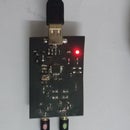Introduction: Getting Started With NodeMCU V1.0 and Blynk App
In this instructable, I will show you how you can connect to ESP 8266 Node MCU to Blynk app and how you can easily implement controlling ESP8266 Node MCU from Blynk for IOT application. Firstly I tried with other normal ESP2866 modules but that doesn’t work for me. Finally I ordered Node mcu v1.0 from amazon in 7$(420 INR).
Here is the link : http://www.amazon.in/ESP8266-NodeMcu-WiFi-Develop...
Advantage of using wifi module over other network protocols is that you can control and monitor through anywhere in the world.
Step 1: Getting Hardware
1. Node MCU V1.0 or ESP8166-12E
2. Mobile (Android or ios)
3. USB Data Cable
4. LED - 1
5. Resistor 1K - 1
Step 2: Installing Arduino Board Package
- Open Arduino IDE in your laptop or PC
Go to File and then preferences. Add http://arduino.esp8266.com/stable/package_esp8266c... into Additional Board Manager URLs field.
Go to tools and then boards and then click on board manager and search ESP8266 in search bar and click on install.
- Wait for installation to finish
Step 3: Testing ESP8266 With Sample Codes
As next step we can check our board by uploading some sample code.
Blink LED: Firstly we can upload blink led code from the examples. Go to File then Examples then drop down and click on esp8266 then click on blink. Compile and upload that code. After uploading on Board LED should blink.
Hello Server: Now we can try connecting to our wifi using esp8266. For that go to file examples and then ESP8266 Web server then hello server. Compile and upload that code.
Don't forget to Change SSID with your wifi name and password with your wifi password.
After uploading also check arduino's serial terminal. On serial terminal it should show connected to wifi network.
Step 4: Getting Started With Blynk
Blynk is a Platform with iOS and Android apps to control Arduino, Raspberry Pi and the likes over the Internet.
It's a digital dashboard where you can build a graphic interface for your project by simply dragging and dropping widgets. It's really simple to set everything up and you'll start tinkering in less than 5 mins. Blynk is not tied to some specific board or shield. Instead, it's supporting hardware of your choice. Whether your Arduino or Raspberry Pi is linked to the Internet over Wi-Fi, Ethernet or this new ESP8266 chip, Blynk will get you online and ready for the Internet Of Your Things.
Step 5: Controlling Led Through Blynk App
- Download Blynk app from playstore or ios
- After installation open the app and create new account by providing maid id then click on create new project icon
- Name your project and select NodeMcu from hardware and connection type Wi-Fi
- Then click on + icon on your upper right side of your main screen to add button to control led
- Drag button icon on the main screen and then click on that button icon
- Change Pin to whatever pin you want to connect your led in output section. I connected led to D7 so i changed pin to D7. Then change the mode type if you want it as switch. Please refer the image
- Then go back to main screen
- Check your mail box. Blynk send you Authorization token. Now we need to install Blynk libraries for arduino
Here is the link : https://github.com/blynkkk/blynk-library/releases/...
- Download all three files
- Then install libraries. In case you don't know how to install Arduino libraries – check here. Follow "Importing a .zip Library" guide.
- Open Blynk ESP8266 standalone example from examples. Add auth token which you get on your mail in that
char auth[] = "";
- Also don't forget to change your wifi ssid and password
- Compile and upload the code
Connecting Led to NodeMcu:
- Connect led ground to GND pin and positive pin to D7 through resistor
- Now come back to your app and click on play icon and then press switch icon
- led should Turn on
Hope you enjoy this instructable












